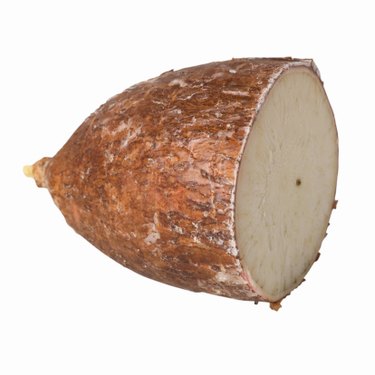
Yucca is the genus comprising more than 40 different evergreen plants in the agave family, characterized by narrow, pointed leaves. Yucca plants typically thrive in warmer climates, and can be found in the American southwest, Mexico, South America and the Caribbean. Yucca plants are related to cassavas (also called yucas), which are also in the agave family but are a distinct genus unto themselves. The most common types of Yucca plants are Yucca filamentosa, Yucca brevifolia (Joshua tree), Yucca aloifolia (Spanish bayonet) and Yucca gloriosa (Spanish dagger). The roots, leaves and fruit of yucca plants were historically used by Native Americans and continue to be used in modern times.
Soap
Video of the Day
The yucca was first described by Swedish botanist Carl Linnaeus in the 1750s in his taxomony of plant and animal species, but it was being used by Native Americans long before that. In fact, Navajos used the yucca root as a soap, pounding the dry roots and whisking them into cold water to create a soapy lather they used to clean clothes, hair and themselves. Yucca suds were also used in Native American rituals involving spiritual cleansing.
Video of the Day
Rope
Native Americans used the thick, fibrous leaves of the yucca to make ropes and cords. After the leaves were soaked in water, they were pounded with stones to separate the leaves' long fibers. The fibers were then twisted together, sometimes with the addition of human or animal hair. The resulting cords were used for belts, rope ladders, sandals, fishing nets and baskets. Archeologists have discovered bundles of prepared yucca leaves, called "quids," in prehistoric structures, indicating that that the use of yucca leaves for this purpose dates back to ancient times.
Food
The fruit of the datil yucca (Yucca baccata) was a source of food for the Pueblo Indians, who would either eat them raw or dry them to be stored for winter. Yucca fruit was also baked and reportedly has a taste similar to that of a potato. The fruit from the yucca can be roasted or eaten raw, and crushed fruit can be used to make cheese using goat's milk. Other parts of the plant can also be eaten; the flower buds are edible if roasted, and leaves can be boiled and eaten. The fruit and root of the yucca are still used in Latin American cooking, sometimes added to soups or stews along with other vegetables. Yucca root can also be prepared by being boiled or fried and is sometimes chopped up and pan-fried like french fries.
Historical Uses
The Navajo used fiber from yucca leaves for making hoops, prayer sticks and chant arrows, and used the plant's juice to make paint and dyes. Native Americans also used yucca for its medicinal properties. After soaking the roots in water, the resulting mixture was offered to a woman in childbirth as a way to reduce pain. Native Americans would mix the juice from a yucca with charcoal from a pinyon or juniper tree that had been struck by lightning to make a poison they would apply to arrow tips.
Modern Uses
In more recent times, yucca has been used as an ingredient in commercially produced products. During the 1970s, the sudsy qualities of the yucca root were used in Yucca-Dew Shampoo. Yucca is also listed as one of the ingredients in Shasta root beer; in fact, yucca is what creates the soda's thick, foamy head after it's poured from can or bottle into a glass. In addition, yucca is the chief ingredient in a line of alternative health products produced by a company called Yu-ccan.